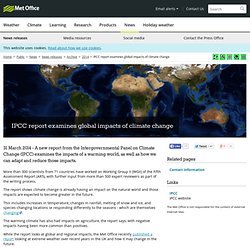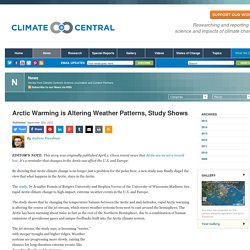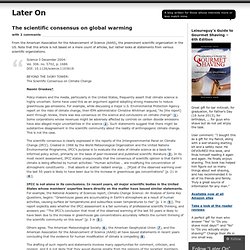

Impact on the poorest. IPCC report examines global impacts of climate change. 31 March 2014 - A new report from the Intergovernmental Panel on Climate Change (IPCC) examines the impacts of a warming world, as well as how we can adapt and reduce those impacts.

More than 300 scientists from 71 countries have worked on Working Group II (WGII) of the Fifth Assessment Report (AR5), with further input from more than 500 expert reviewers as part of the writing process. The report shows climate change is already having an impact on the natural world and those impacts are expected to become greater in the future. This includes increases in temperature, changes in rainfall, melting of snow and ice, and species changing locations or responding differently to the seasons - which are themselves changing. The warming climate has also had impacts on agriculture, the report says, with negative impacts having been more common than positives. IPCC report examines global impacts of climate change. Stopco2. NEW WORLD VIEWS. Climate Change: Vital Signs of the Planet.
Global Warming Facts, Causes and Effects of Climate Change. Jump to Section Q: What is global warming? A: Here's a simple definition of global warming. (And yes, it's really happening.) Over the past 50 years, the average global temperature has increased at the fastest rate in recorded history. And experts see the trend is accelerating: All but one of the 16 hottest years in NASA’s 134-year record have occurred since 2000. Climate change deniers have argued that there has been a “pause” or a “slowdown” in rising global temperatures, but several recent studies, including a 2015 paper published in the journal Science, have disproved this claim.
Q: What causes global warming? A: Global warming occurs when carbon dioxide (CO2) and other air pollutants and greenhouse gases collect in the atmosphere and absorb sunlight and solar radiation that have bounced off the earth’s surface. Arctic Warming is Altering Weather Patterns, Study Shows. EDITOR'S NOTE: This story was originally published April 3.

Given recent news that Arctic sea ice set a record low, it's a reminder that changes in the Arctic can affect the U.S. and Europe. By showing that Arctic climate change is no longer just a problem for the polar bear, a new study may finally dispel the view that what happens in the Arctic, stays in the Arctic. The study, by Jennifer Francis of Rutgers University and Stephen Vavrus of the University of Wisconsin-Madison, ties rapid Arctic climate change to high-impact, extreme weather events in the U.S. and Europe.
The scientific consensus on global warming « Later On. From the American Association for the Advancement of Science (AAAS), the preeminent scientific organization in the US.

Note that this article is not based on a mere count of articles, but rather looks at statements from various scientific organizations. Science 3 December 2004: Vol. 306. no. 5702, p. 1686 DOI: 10.1126/science.1103618BEYOND THE IVORY TOWER: The Scientific Consensus on Climate ChangeNaomi Oreskes*Policy-makers and the media, particularly in the United States, frequently assert that climate science is highly uncertain. Some have used this as an argument against adopting strong measures to reduce greenhouse gas emissions. For example, while discussing a major U.S. Climate Change: Vital Signs of the Planet. Planetary boundaries. Physical Sciences Division. CLIMATE 101. Climate Change, Deforestation, Biomes and Ocean Currents, Plankton, Endangered Species - Earth Web Site. Click for more detail.

Ocean acidification. NOAA provides evidence for upwelling of corrosive "acidified" water onto the Continental Shelf.

In the figure above, note the vertical sections of (A) temperature, (B) aragonite saturation, (C) pH, (D) DIC, and (E) pCO2 on transect line 5 off Pt. St. George, California. Shutdown of thermohaline circulation. A summary of the path of the thermohaline circulation.

Blue paths represent deep-water currents, while red paths represent surface currents A shutdown or slowdown of the thermohaline circulation is a postulated effect of global warming. Thermohaline circulation and fresh water[edit] Current sea level rise. Trends in global average absolute sea level, 1870–2008.[1] Changes in sea level since the end of the last glacial episode. Current sea level rise is about 3 mm/year worldwide. According to the US National Oceanic and Atmospheric Administration (NOAA), "this is a significantly larger rate than the sea-level rise averaged over the last several thousand years", and the rate may be increasing.[2] This rise in sea levels around the world potentially affects human populations in coastal and island regions[3] and natural environments like marine ecosystems.[4] Between 1870 and 2004, global average sea levels rose 195 mm (7.7 in), 1.46 mm (0.057 in) per year.[5] From 1950 to 2009, measurements show an average annual rise in sea level of 1.7 ± 0.3 mm per year, with satellite data showing a rise of 3.3 ± 0.4 mm per year from 1993 to 2009,[6] a faster rate of increase than previously estimated.[7] It is unclear whether the increased rate reflects an increase in the underlying long-term trend.[8]